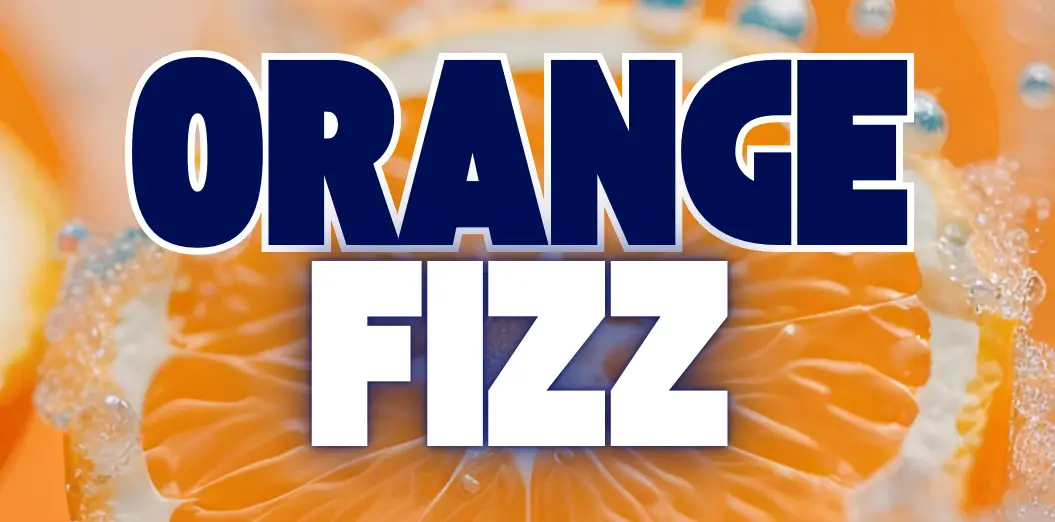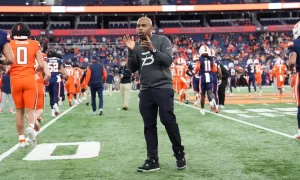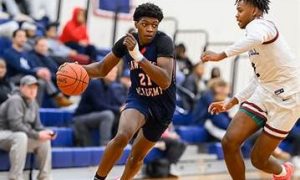Syracuse men’s basketball’s putrid start to the season has felt like one large lump of coal in Orange Nation‚Äôs collective stocking. SU has dropped five nonconference games for the first time since Jim Boeheim took the reins in 1976, leaving the team in grave danger of missing the NCAA Tournament. Of course, Syracuse still has the entire ACC slate to make a positive impression on the selection committee (I suppose it could win the conference tournament, but the odds of that happening are about as good as those of Boeheim complimenting a reporter).
SU has revealed itself to be a deeply-flawed team, and a few quick strategic tweaks won’t fix the group’s woes. With that said, Boeheim can order his players to make a couple shifts on offense that could boost the Orange’s efficiency and jump-start a one-eighty.
First, Syracuse needs to slow down, which feels counter-intuitive, because struggling offenses should always seek out easy buckets in transition. But this year’s Orange has floundered on the fastbreak.
In terms of pace of play, Syracuse is middle-of-the-pack: SU shoots in transition on 25.7 percent of its possessions, the 153rd-highest rate in the nation (all numbers used in this article are courtesy of hoop-math.com). That number should come down, because the Orange’s effective field goal percentage on the fastbreak is a repulsive 48.7, which checks in at No. 314 (out of 351 Division I teams) on the national leaderboard. And Syracuse is not a bad offensive team in all settings — on non-transition shots, Syracuse’s eFG is 54.9 percent, the country’s 29th-best mark.
(Note: eFG is a better metric than raw FG% because it accounts for the added value of a 3-pointer; more on the striking revelation that three is greater than two in a moment.)
Boeheim’s team is especially horrendous when it pushes the pace after forcing a turnover, with an eFG of 40.9 percent on shots taken within 10 seconds of a steal (sixth-lowest in the nation). That number provides a cold dose of reality for SU fans — this season, the quixotic image of the 2-3 zone frequently forcing turnovers that directly lead to easy Orange buckets on the other end is a myth.
Considering the team’s personnel, Syracuse’s transition issues are shocking. The roster features lightning-quick ball-handlers (John Gillon and Tyus Battle), guards who can rebound and ignite a fastbreak by themselves (Frank Howard and Andrew White III), big men who gallop down the floor like gazelles (Taurean Thompson and Tyler Roberson), and — in theory, at least — tons of shooting (the entire backcourt, plus Thompson and Tyler Lydon).
For some reason, though, SU is awful in transition. Perhaps it’s due to an inability to protect the ball, thanks mostly to shaky guard play, but the Orange actually owns an above-average turnover rate (18.6 percent, 135th in the nation, per KenPom.com). In losses, however, Syracuse has coughed up the rock 14.2 times per game, which would rank 225th over a full season. Whatever the cause, the bottom line is that SU is dreadful when it runs. Unless the team has numbers, it should almost always wait to set up its halfcourt offense.
Another thing the Orange should almost always do is trade out mid-range jumpers for 3-pointers. The death of the long two in the NBA has been well-documented, and the practice of ignoring the mid-range is famously employed by hyper-efficient players like Houston guard James Harden.
Syracuse should take a page from the MVP candidate’s book, because — aside from the obvious fact that three is more than two (math!) — the Orange is much more efficient when it takes the extra step back and shoots from beyond the arc.
SU connects on 38.9 percent of its 2-point jumpers, which ranks 98th in the country; that’s a fine number, but it’s actually lower than the Orange’s mark from downtown. Syracuse drills 39.4 percent of its triples, good for 43rd among NCAA teams. Basic multiplication reveals that the team’s 2-point jump shots yield an average of .78 points, while its 3-pointers carry an expected value of 1.18 points (you can only find these types of advanced calculations on Orange Fizz).
I understand that it’s nearly impossible to completely toss out the mid-range jumper (especially with DaJuan Coleman on the roster), but look at Harden’s Rockets as an example of a team taking this idea to the extreme. Houston averages 7.8 mid-range field goal attempts per game, by far the lowest number in the league, and 39 3-point attempts per game, by far the highest number in the league. In other words, the Rockets shoot five treys for every one mid-range attempt. Head coach Mike D’Antoni’s team is radical, to be sure — but is averaging 114.5 points per 100 possessions, making Houston the league’s fourth-best offensive team.
Syracuse, meanwhile, takes 40.5 percent of its shots from distance, and 25.4 percent of its shots from the mid-range. That’s a good start, but nowhere near the five-to-one ratio that the Rockets have proven possible.
All these numbers prove that the Orange needs to essentially ignore two staples of basketball offense: transition and the mid-range. It may sound crazy, especially to old-school hoops junkies — but the figures paint the picture, and at this point, Boeheim may be willing to try anything.


















